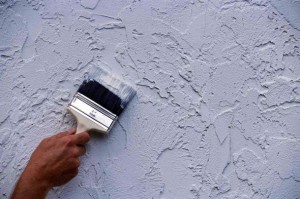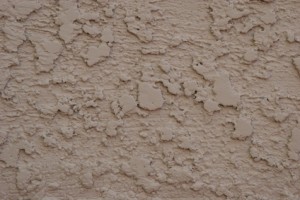Stucco is an incredibly durable, versatile product that has been used as a popular building material for over 100 years. Stucco is a type of plaster made by mixing cement, sand, and lime with water, then applying it to the exterior and interior walls of your home.
It is environmentally safe and clean, and allows for air infiltration, keeping your home fresh and comfortable. It also acts as an excellent barrier against termites and woodpeckers that will slowly deteriorate your home.
Stucco is an excellent choice for your home”™s exterior because it provides a hard, durable, weather-resistant outer surface that protects from all the elements. Stucco is also breathable, making it rot- and fungus-resistant. However, over time, stucco exteriors can suffer small chips, fractures, stains, and fading that may need to be repaired.
There are two different kinds of stucco finishes: cement-based stucco and exterior insulation and finish system (EIFS).
Cement-based Stucco
Cement-based stucco is a combination of portland-based cement and sand that is usually applied onto metal lathe. This is the real or more traditional type of stucco. Applying this stucco requires three different coats of cement, with the final coat acting as a texture coat. Color can be added to the texture coat, and is compatible with most paints, coatings, and special finishes.
The initial investment is high, but it will eventually pay for itself. This type of stucco, when properly maintained, will last for 50 years or more. Stucco resists fading, so you won”™t need to touch it up very often, if ever. Cement-based stucco is water-resistant and very suitable for people living in high-humidity areas.
Exterior Insulation and Finish System (EIFS)
This is an exterior wall system with a final finish that resembles stucco. However, this is not to be confused with portland-based cement plaster. This is a synthetic type of stucco, using a styrofoam layer that is coated with a thin amount of cement and an acrylic layer of textured stucco. EIFS is lightweight, easy to install, and available in different colors and decorative finishes to suit many different kinds of building requirements. It can be installed over wood frames, steel walls, or masonry. EIFS is also water- and impact- resistant.
Painting Stucco
Over time, these types of stucco can suffer the inevitable wear and tear, and may need to be re-painted. You can paint your stucco to give it a fresh look, while keeping the texture in tact. Surfaces don”™t need to be primed unless they”™re chalky, cracking, or stained. If that”™s the case, then it”™s a good idea to prime the surface.
You may already know what color of paint you want, but the type of paint you use can prove to be just as important. When painting stucco, you do not want to use a high-gloss paint. Flat and low-sheen paints are preferable.
A good quality acrylic latex paint formulated specifically for stucco, or an elastomeric caulk is the best choice when repainting your stucco. Acrylic latex provides excellent protection; however, if you need something stronger to protect against wind-driven rain, elastomeric caulk is the better choice. Elastomeric is known for its heavier film build and elasticity, which provides the highest degree of protection possible.
Not sure if this is a project you”™d like to take on yourself? Give us a call and we”™ll be happy to take care of it for you!


